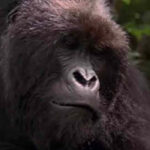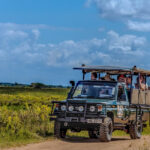If you follow my blog you will know that I use my own trail camera / camera trap. I bought it for my big move to safari school in South Africa. As a safari guide, I thought it would be awesome to know what critters are creeping around my tent at night! But, I’ve had a lot of hit-and-miss with it. Trying to work out the best locations and positions is not always straight forward. Add to that I’ve mostly been in national parks, so I wasn’t allowed to place the camera beyond camp and it becomes very difficult.
However, now that I’m working in a private reserve, I have a little more freedom than usual! At first I tried to position it along a road that I knew was a popular stomping ground for my favorite resident leopard, Saseka. However, she proved far too intelligent and elusive. After a couple of weeks of just impala and hyena, I decided to try something new.
An African civet caught on a trail camera – these nocturnal creatures are notoriously difficult to photograph!
Instead of putting the camera trap somewhere I thought got heavy traffic, I did the exact opposite. I moved it to one of the quieter parts of the reserve that we rarely drive. This was with a kind of scientific curiosity to find out what really is moving around there. Honestly, I didn’t expect to pick-up much. But, with plenty of signs showing a rhino in the area, I hoped to discover who this mystery bull was. Thus, I pitched my trail camera opposite one of his dung middens.
I left the camera trap at the midden for longer than usual to maximise my chance of a sighting. Thus, after ten days patiently biding my time, I finally went to collect it. I was quietly hopeful that I’d got a picture of the rhino as there seemed to be some fresh tracks and scrapings nearby. However, there didn’t look to be much other spoor so I figured the area really was devoid of life after all.
Well, imagine my surprise when I saw that in just ten days I managed to capture the entire Big Five (lion, leopard, rhino, buffalo and elephant), plus hyena, civet, giraffe, jackal and more! This was supposed to be the quiet part of the reserve! In all my months of using my camera trap I’ve never come close to such an awesome set of sightings – it’s incredible. Keep scrolling to watch my awesome video of the best bits from the whole ten days!
What camera trap / trail camera do I use?
If you are planning on buying a camera trap then I thoroughly recommend the Browning Strike Force HD. It’s not a fancy camera with SMS settings or a screen embedded, so it won’t cost you a fortune. But it has just what I needed; a decent lens and resolution, great shutter speed and an option to take up to eight photos in a burst. Add in a good infra-red camera and the fact it’s super easy to use and I was sold.
If you also want to set it up in a Big Five reserve, I highly recommend getting a protective steel cage and master python cable. Hyena are especially curious and could quite easily bite the camera and carry it off. Elephants are known to knock entire trees down just because they are in a bad mood. Imagine what they could do to your camera trap if they didn’t like it! On one particular occasion I actually found tusk marks all over a tree I had mounted my trap on – luckily the cage and cable meant that my investment remained unscathed.

